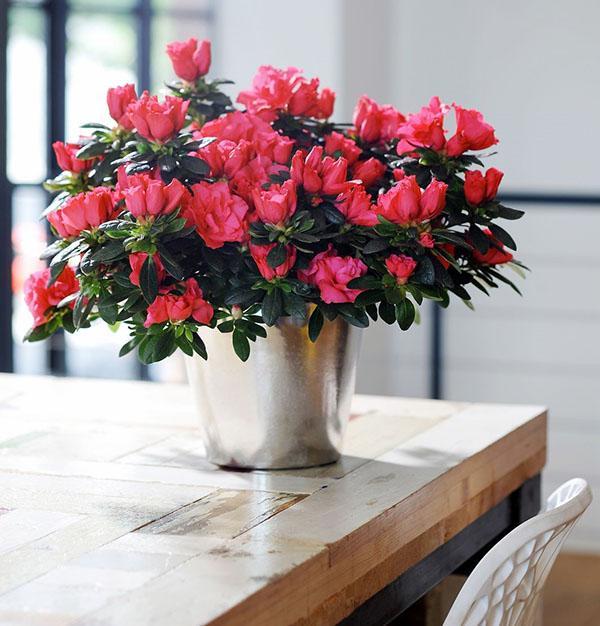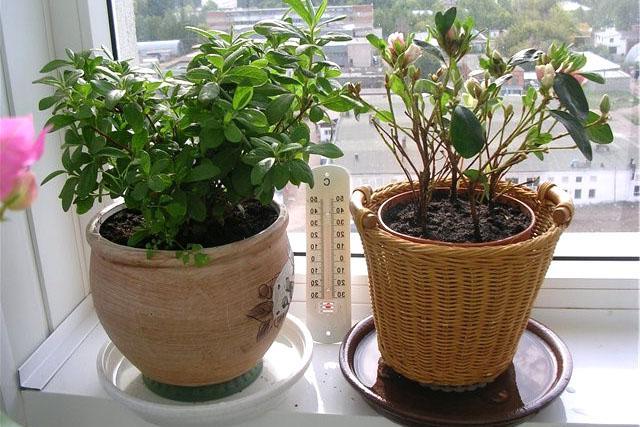Painstaking care for azalea at home
 The blooming of a room azalea is impossible to miss. One of the most beautiful indoor plants amazes with both the number of simultaneously opening buds and the variety of colors. And indoor azalea blooms in the darkest time of the year - in winter, when the sun and bright colors are so lacking. But due to improper home care, azaleas often disappoint owners. Together with regular flowering, the plants lose their foliage and dry out.
The blooming of a room azalea is impossible to miss. One of the most beautiful indoor plants amazes with both the number of simultaneously opening buds and the variety of colors. And indoor azalea blooms in the darkest time of the year - in winter, when the sun and bright colors are so lacking. But due to improper home care, azaleas often disappoint owners. Together with regular flowering, the plants lose their foliage and dry out.
In order for the azalea to fully reveal its natural character and decorate the house for many years, it needs conditions and attention that are comfortable for growth.
Under indoor conditions, two types of azaleas are most often grown: Indian and Japanese. Both species stand out from the extensive genus of rhododendrons:
- compactness and small size;
- slow growth;
- abundant flowering and richness of shades.
If you choose several varieties of indoor azaleas with different flowering periods among the numerous varieties of indoor azaleas, a cloud of bright flowers will hover over the windowsill from November to May.
On this topic:azalea - home care after purchase!
Conditions for keeping room azalea

- bright but diffused light;
- abundant watering;
- looseness and acidity level of the substrate;
- low air temperature in the room where the pot of azalea is located.
The optimum humidity is 70–80%. When caring for an azalea flower, the plant should not be left in dry air for a long time, otherwise it will lose foliage and slow down development. An excess of light and a lack of it lead to the same problems.
 Compliance with these conditions in the room depends on how abundant the following flowering will be:
Compliance with these conditions in the room depends on how abundant the following flowering will be:
- In autumn and winter, when flower buds are laid, indoor azaleas require an air temperature of 6–8 ° C. In this case, the pots are left in a lighted place, but water is very limited.
- In the spring, with the appearance of buds watering renewed in the same volume, and the azaleas are transferred to a room with a temperature of 12-16 ° C. If the room is warmer, even with proper maintenance of potted azaleas, flowering can be severely reduced.
- In the summer months, the culture feels best at a temperature of 20-22 ° C, and indoor azaleas can easily tolerate being on the balcony, loggia and in the garden, if the plants are protected from direct sunlight.
Excessively high temperature and dry air provokes an attack on azaleas by spider mites and other insect pests. When kept in the garden, plants should be protected from scale insects, aphids and leaf rollers.
Watering and irrigating indoor azaleas
Azaleas growing in rooms are very sensitive to watering. During flowering and active growth, the soil under the plants should not dry out. Since both garden and pot varieties of this culture prefer an acidic substrate, they cannot be watered with tap water. Moisture is either defended or filtered.
Periodically acidified with citric acid, ascorbic acid, vinegar or lemon juice. Add 0.3-0.4 grams of acid per liter of water. You should not abuse this method; when caring for azaleas indoors, on young shoots and leaves, the owner may notice pinkish-purple spots, and the greens dry out and turn yellow below.
If, during watering, water flows into the sump, it must be drained to avoid root rot. This is especially important when the air temperature drops in the autumn-winter period.
And during hot weather or when the heating is running, azaleas are irrigated with clean, settled water. During flowering, this procedure is carried out very carefully, trying not to get on flowers and buds, since spots and stains remain on delicate petals.
Top dressing for indoor azaleas
 In the spring, but the beginning of flowering, and then after the flowers wither, you need not only the usual care of azaleas at home, but also complex feeding.
In the spring, but the beginning of flowering, and then after the flowers wither, you need not only the usual care of azaleas at home, but also complex feeding.
For these purposes, a specialized fertilizer for rhododendrons and azaleas is suitable:
- To stimulate the formation of buds and flowering in the spring, indoor azaleas are fertilized with compounds with a predominance of phosphorus and potassium.
- When the flowers fall and the shoots begin to grow, nitrogen fertilizers are included in the care of the azaleas in the pot.
In order for the plant to go prepared for the winter, feeding the azaleas is stopped in mid-September. This is especially true for making nitrogen fertilizersstimulating the formation of foliage and new shoots.
A video about azaleas at home, about caring for and growing plants will replenish the theoretical knowledge of the florist and help you understand the features of agricultural technology.
Pruning and pinching azaleas for indoor care
 The end of flowering in azaleas coincides with the beginning of the appearance of new and regrowth of old shoots. In order for the bush to remain compact in indoor conditions and delight with flowers next spring, the plants must be cut off in time.
The end of flowering in azaleas coincides with the beginning of the appearance of new and regrowth of old shoots. In order for the bush to remain compact in indoor conditions and delight with flowers next spring, the plants must be cut off in time.
Pruning bushes, in the care of azaleas, as in the photo, have been included since mid-May. At this time, weak, overly elongated or old shoots are subject to removal. Azalea buds appear on one-year-old shoots, so new strong shoots are left, and the rest of the shoots are at least pinched to cause branching and laying of flower buds.
Indoor azaleas, when grooming and pruning, lend themselves well to shaping and are used to create bonsai and compositions with other ornamental crops. 2-3 weeks after pruning, the shrub is covered with new foliage.
Planting and caring for azaleas
 As they grow, the bushes are transplanted. Young plants are transferred to a new larger container annually, and then, after 3-4 years, the transplant is carried out as needed.
As they grow, the bushes are transplanted. Young plants are transferred to a new larger container annually, and then, after 3-4 years, the transplant is carried out as needed.
Indoor azaleas have a shallow root system, so pots that are wider than depth are best suited for the plant. The capacity is chosen with the calculation of mandatory drainage with a thickness of at least 3 cm.
The best soil for indoor azaleas is a mixture of two parts of rotted steamed needles of one part peat... Fertile humus, sand and crushed sphagnum are added to the loose substrate. Before planting, the soil is sterilized to exclude infection of plants by nematodes, mealybugs and harmful fungi.
 The drainage layer is best made from shards of ceramic or expanded clay with the addition of pieces of pine or spruce bark. The last component is especially important when planting and caring for azaleas. It provides constant soil acidification. But limestone cannot be used, because because of it the soil changes its reaction. Ideally, the acidity of the soil should be 3.0–5.0 units.
The drainage layer is best made from shards of ceramic or expanded clay with the addition of pieces of pine or spruce bark. The last component is especially important when planting and caring for azaleas. It provides constant soil acidification. But limestone cannot be used, because because of it the soil changes its reaction. Ideally, the acidity of the soil should be 3.0–5.0 units.
When transplanting as part of azalea flower care, it is important that the root collar remains above ground level. After filling it, it is slightly compacted, moistened, and, if necessary, filled up. The best time to transplant is at the end of winter, when the plant is not yet showing signs of growth, or after mass flowering is complete.
If, before transferring to a new pot, the flower has not completely bloomed, it is better to cut the buds so that they do not weaken the already injured plant.
Reproduction of azaleas at home
 Indoor azaleas can not only be kept in bloom, but also propagated.This is quite simple to do:
Indoor azaleas can not only be kept in bloom, but also propagated.This is quite simple to do:
- when transplanting, dividing an adult bush;
- in summer, semi-lignified cuttings cut from the tops of the shoots.
A large plant is divided so that each of the young azaleas has a viable root system. Sections of large shoots are treated with a small amount of garden varnish. It is useful to powder the roots with crushed charcoal and a growth stimulant. Planting and caring for azaleas in this case has no features, except that it is better to prune the bush so that it takes root faster.
Rooting of cuttings is carried out from May to September. The apical parts of faded shoots 10-15 cm long with several developed leaves are dropped into a loose acidic substrate and kept in a greenhouse at a temperature of 25 ° C. The formation of roots in indoor azaleas is slow. Such a plant will be ready for transplantation into a separate container only after a few months, and the first flowers will be opened next year.